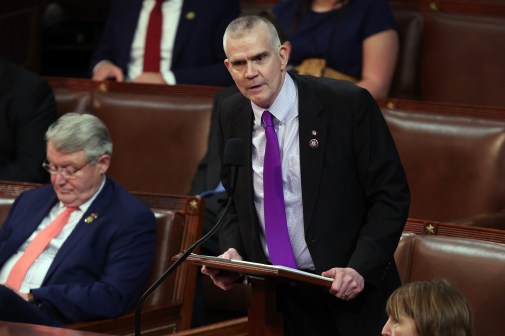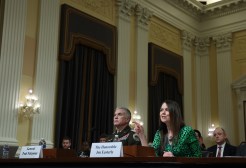Lawmakers call on president to demand VA-DOD health interoperability

New VA CIO LaVerne Council testifies on her office’s plans to bring interoperability to troops’ medical records as they transition from DOD to the VA. (Hearing screenshot)
It could take pressure from President Barack Obama to get the departments of Defense and Veterans Affairs to agree on an interoperable system for handling servicemembers’ and veterans’ electronic health records, lawmakers said this week.
“I’ve reached the conclusion that the only person who can referee this dispute between these two departments is the president,” said Rep. Beto O’Rourke, D-Texas. “And it must become a priority of his. Unless he says to the secretary of Defense and the secretary of VA, ‘You have to find a way to get to a unified system …,'” this won’t get done, he said.
O’Rourke spoke during a joint hearing of the House Oversight and Government Reform Subcommittee on IT and the Committee on Veterans Affairs’ Oversight and Investigations Subcommittee, convened to look into the congressional mandate on the two departments to integrate digital medical records to reduce delays and errors in the transition process as troops become veterans.
One of several representatives frustrated with DOD and the VA’s lack of progress, O’Rourke said it seemed like only a personal intervention by the president could force the departments to finally fall into line behind the health record sharing milestones set forth in past National Defense Authorization Acts.
Until this point, the departments have wavered back and forth between merging their systems and developing separate but interoperable systems. In 2011, VA and DOD decided on building a single, unified integrated electronic health record system, and spent $564 million on that effort before abandoning it in 2013 in favor of a plan to each modernize their own EHR platforms. VA has been working to update its Veterans Health Information Systems and Technology Architecture, known as VistA, while DOD has been pursuing is own modernization program, recently awarding a multimillion-dollar electronic health records contract — all the while failing to comply with national data standards on time, as required by the fiscal year 2014 NDAA, according to the Government Accountability Office.
“We’ve had a lot of concerns about the starts and stops of this,” said Valerie Melvin, director of GAO’s Office of Information Management and Technology Resources Issues, which developed a report in August criticizing the departments’ inability to set strong goals for achieving interoperability. “It has been a history of the two departments going down particular paths that they wanted pursue for this, changing at certain points, and there has not in our view been the accountability for them doing it.” She said it would not surprise her if the departments realistically spent more than a billion dollars so far.
Most lawmakers, like Democratic Rep. Ted Lieu of California, still think the departments should pursue a single system. “Two separate modernizations are a mistake,” he said.
“Frankly, I agree that the president really needs to make this a priority to make this happen,” said Rep. Dan Benishek, R-Mich. “We can’t stand the fact that we’re spending a billion dollars on integrating health care, and then you tell us it can’t be done … We get sick of this. And really I want the president to be involved.”
Officials leading the development of the departments’ EHR systems described throughout the three hour-plus hearing a complex process to modernize and digitize what are essentially the nation’s two largest health care providers, saying they should reach standards for elementary interoperability by 2016. Though the two organizations serve such similar purposes and treat essentially the same populations at different points in their lives, Christopher Miller, program executive officer for DOD’s Defense Healthcare Management Systems, said it’s a matter of different “operating environments” leading them to separate systems.
“I’m worried about making sure it works on a submarine beyond periscope depth. I’m worried about it working in Afghanistan [via satellite]. I’m worried about it taking care of children,” Miller said. “The two departments do have different organizational missions when it comes to health care delivery.”
VA Chief Information Officer LaVerne Council said the lifelong context for which her department must account brings different requirements.
“Our clinical capabilities and what we have to do for a veteran from the time they become a veteran to the time they leave this Earth is a much holistic calling,” Council said. “And for us it is about the total health capability of that veteran and for us managing the care of that veteran during that time.”
Miller and Council, who are relatively new to the saga of DOD-VA EHR interoperability, said the reason for past failures was nontechnical.
“It’s bigger than the IT. The IT is actually the easy part of what we’re talking about here today,” Miller said. “What we don’t seem to ever want to tackle are the people stuff, the process stuff, all the things that make business systems really hard.”
He continued: “What DOD and the VA are doing right now are getting both houses in order to position us for the future where we’re actually ready to have the discussion about moving to a single system,” adding that the attempt to move to a single system in 2011 was ahead of their capabilities, and “we fundamentally set ourselves up to fail.”
It takes “making some hard decisions and holding people accountable to achieve the things we said we would do,” said Council, something she said the VA hasn’t done before, but she plans to in her new role.
GAO’s Melvin agreed: “We have not seen the dedication on the part of the two departments to take a stand on that and to make it stick.”
But many of the representatives seemed to take the hours of testimony as simply more excuse-making. Some wondered how Uber could become a billion-dollar company in a handful of years and the U.S. could put a man on the moon, but the VA and DOD can’t seem to achieve EHR interoperability in almost two decades.
DOD’s Miller pointed out that interoperability issues aren’t unique to their departments; it’s a “national issue,” and frankly it’s worse in the private sector, he said.
Rep. Gerry Connolly, D-Va., didn’t like that too much.
“It is a national issue; but we’re talking about two federal agencies that deal with a specific population in our care,” he said angrily. “One of the problems is we’ve had bureaucratic inertia between two agencies that can’t get their acts together on behalf of the men and women we’re serving. That’s the issue. Not that there’s some national problem that’s bigger than all of this. This is conquerable. This is within our purview. You’re federal agencies, and you owe more to the men and women who’ve served this country than they’re getting.”





